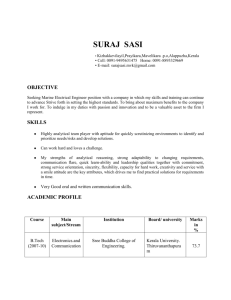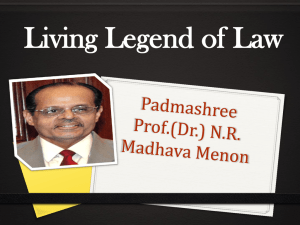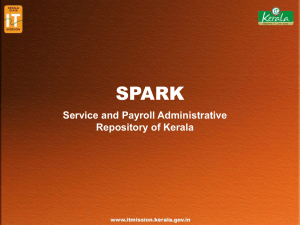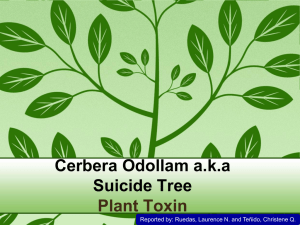Report 1 - Little Flower College Guruvayoor
advertisement
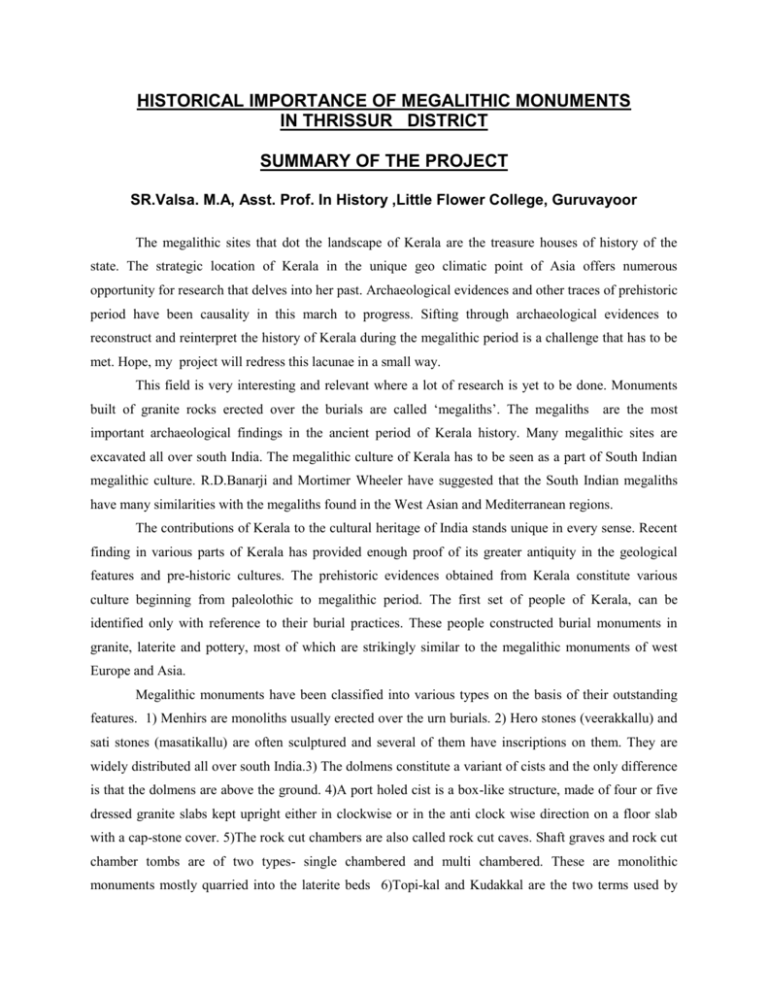
HISTORICAL IMPORTANCE OF MEGALITHIC MONUMENTS IN THRISSUR DISTRICT SUMMARY OF THE PROJECT SR.Valsa. M.A, Asst. Prof. In History ,Little Flower College, Guruvayoor The megalithic sites that dot the landscape of Kerala are the treasure houses of history of the state. The strategic location of Kerala in the unique geo climatic point of Asia offers numerous opportunity for research that delves into her past. Archaeological evidences and other traces of prehistoric period have been causality in this march to progress. Sifting through archaeological evidences to reconstruct and reinterpret the history of Kerala during the megalithic period is a challenge that has to be met. Hope, my project will redress this lacunae in a small way. This field is very interesting and relevant where a lot of research is yet to be done. Monuments built of granite rocks erected over the burials are called ‘megaliths’. The megaliths are the most important archaeological findings in the ancient period of Kerala history. Many megalithic sites are excavated all over south India. The megalithic culture of Kerala has to be seen as a part of South Indian megalithic culture. R.D.Banarji and Mortimer Wheeler have suggested that the South Indian megaliths have many similarities with the megaliths found in the West Asian and Mediterranean regions. The contributions of Kerala to the cultural heritage of India stands unique in every sense. Recent finding in various parts of Kerala has provided enough proof of its greater antiquity in the geological features and pre-historic cultures. The prehistoric evidences obtained from Kerala constitute various culture beginning from paleolothic to megalithic period. The first set of people of Kerala, can be identified only with reference to their burial practices. These people constructed burial monuments in granite, laterite and pottery, most of which are strikingly similar to the megalithic monuments of west Europe and Asia. Megalithic monuments have been classified into various types on the basis of their outstanding features. 1) Menhirs are monoliths usually erected over the urn burials. 2) Hero stones (veerakkallu) and sati stones (masatikallu) are often sculptured and several of them have inscriptions on them. They are widely distributed all over south India.3) The dolmens constitute a variant of cists and the only difference is that the dolmens are above the ground. 4)A port holed cist is a box-like structure, made of four or five dressed granite slabs kept upright either in clockwise or in the anti clock wise direction on a floor slab with a cap-stone cover. 5)The rock cut chambers are also called rock cut caves. Shaft graves and rock cut chamber tombs are of two types- single chambered and multi chambered. These are monolithic monuments mostly quarried into the laterite beds 6)Topi-kal and Kudakkal are the two terms used by local people for the monuments belonging to the umbrella stone series, and they were first rendered into English as ’hatstone’ and’ umbrella stone ‘by J.Babington in 1819. Each topikal or ‘hatstone’ rests upon four quadrantal clinostatic stones joining up together into a square at the base on the outside and believed in such a way as to close up along the diagonals of the square. 7)Among the burial systems of Kerala, urn burials were predominant. The urns are generally found scattered and only rarely in alignments. The urns and pits are generally scaled by stone slabs and at times by ceramic vessels. 8)A sarcophagus is literally a legged coffin made of terra-cotta. Tomb-shaped many legged sarcophagi is almost like a bath – tub. After placing the burial articles and dead body in the tomb sacrophagi have been reported from kattakambal in Thrissur District. The megalithic monuments are visible in almost all parts of south India. A lot of megalithic sites can be seen in Thrissur district such as Cheremanganad, Porkkulam,Kakkad,Eyyal, Kattakambal, Chowannur, Ariyannoor, Kandanassery, Machad, Mangad, Thiruvilvamala, Varandarappilly, Ramavarmapuram etc. It represented by funeral monuments created out of huge blocks of stone. In these monuments, along with the corpus, the most valuable possession of the dead like the tools and weapons, ornaments, pots, dress, food items, coins, beads etc…were buried. The excavations reveal that there are variations in the character and style of construction of megalithic monuments from region to region. But there are numerous common features for all of them. Scholars studied the megalithic culture in detail and put forward their valuable opinions about them. Haimendrot, the great Archeologist equates the iron using megalithic people with the Dravidians who migrated from the west and suggested that the megalithic culture entered in India perhaps between 700 and 500 B.C. This period is generally accepted as the period of the origin of megalithic culture in south India by the scholars. D.H. Gordan in his work “Pre historic Background of Indian culture” support the date suggested by Haimendrot. But many other scholars suggested that this culture developed in between BC 500 to 1000 A.D. The period marked the transition from the food gathering stage to food producing phase of human culture in south India. The nomadic and wandering life of people for their food and other essentials gradually disappeared and they began to settle permanently on the banks of river valleys and the hill slopes and began to cultivate the soil in their surroundings. The megalithic people were responsible for the introduction of a systematic and developed agricultural economy based on iron tools and irrigation in South India .As a result of this, permanent agrarian settlements developed in many areas in South India during this period. The material remains obtained from the excavation reveals that in south India chalcolithic culture was changed into megalithic culture using Iron tools and implements. Stone axes, choppers, scrappers, cleavers, points etc. are the common type of tools. The discovery of the skeleton of dogs buried along with the skeleton of man obtained from excavated sites reveals that they practiced domestication. By analyzing the relics from the megalithic monuments , we got a clear image of rural Kerala. Starting from stone age, Kerala must have been the site of human settlement. This is evidenced by the presence of a large number of megalithic sites in Kerala. Iron tools and implements are common in almost all the burial graves and they are similar also. Among the most common tools are flat iron axes, shaft whole axe, and a variety of flanged shape hoe, pick axe ,bill hooks, iron wedges and crowbars. Spear like objects, arrow heads, blades were also found. These iron artifacts points towards different economic functions of that time. Hunting was a major economic function of the people at one stage as the tools used hunting was very large among the findings. Towards the end of the megalithic period the cultural phase was undergoing a transition from pastoralism to agriculture. From the objects which we got from these megalithic sites, we can interpret the lifestyle of the people their culture, social structure and religious beliefs. The megalithic people of Kerala might have led a semi-nomadic pastoral life combined with high land agriculture. Agriculture was practical and iron tools enables them to clear the forests and till the land is a systematic manner enabling them to produce results. The iron objects like arrow heads, spear heads, sword, dagger, tripods etc indicated that warfare was a common practice at that time. The difference in the size of megalithic burials indicate to the social inequalities in the society. Some of the burials have precious stones and other objects which denote to the political and religious importance of the person buried. Historians generally differ in fixing the period of the megalithic culture of Kerala. From available evidence, it could be inferred that the megalithic culture existed in Kerala during the period between BC 6th century and 2nd Century BC. One of the most important finding related to megalithic culture in Kerala is that the ‘Kudakkallu’ is a unique mushroom – shaped megalithic burial monument of Kerala. Nowhere else in the world is this kind of megalithic burial site found. The Archaeological Survey of India is trying to get these sites included in the World Heritage list. Thrissur district in Kerala is the most important and valuable site of megalithic culture in Kerala. The megalithic monuments in Kerala have more historical importance. Through the study of megalithic sites of Kerala, we can reconstruct its early history. By urging the students of history to know about the relevance and importance we can conserve our historical sense. Encouraging Field visit to all these megalithic sites in Kerala, we can create great historic potential in the minds of students.


